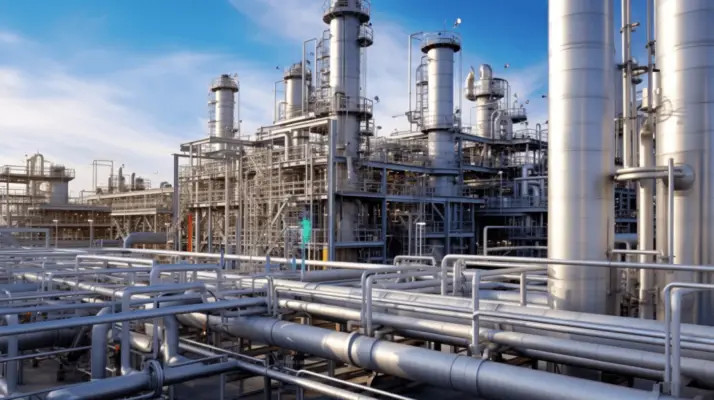According to my search results, hazard identification and risk analysis are important components of any risk management plan.
A guide by SafetyCulture recommends building workflows around safety practices and procedures that were created based on risk assessments. The guide also suggests relaying best practices and standard procedures to employees.
A study published in the National Library of Medicine found that hazard identification, risk assessment, and control measures are effective tools for occupational health assessment in hazardous industries.
The study identified all possible hazards at different workplaces of an iron ore pelletizing industry and conducted an occupational health assessment to control the identified hazards.
According to an article by AuditBoard, there are nine steps to boost your risk management plan using risk assessment analytics.
These steps include classifying your data, determining data accessibility, and analyzing data to identify trends and patterns.
ISACA recommends using both qualitative and quantitative risk assessment and analysis methods.
Quantitative risk analysis requires high-quality data, a definite business plan, and a well-developed project.
Let’s delve into hazard identification and analysis and discover the key methods to mitigate risks.

What is Hazard Identification and Analysis?
Hazard identification and analysis is a critical process for identifying potential risks and hazards in a workplace or project. It involves:
- Identifying and evaluating potential hazards.
- Assessing their potential impact and likelihood.
- Implementing appropriate measures to control or mitigate them.
This process is important because it helps organizations proactively identify and address potential hazards before they cause harm or damage.
Why is Hazard Identification and Analysis Important?
Hazard identification and analysis play a pivotal role in ensuring the safety and well-being of individuals and organizations.
Systematically identifying potential risks and evaluating their impact, organizations can develop effective risk controls and standard operating procedures.
The practice of hazard identification involves following specific steps and procedures. This allows organizations to identify potential hazards and assess the level of risk associated with each hazard.
Understanding and addressing potential hazards through hazard identification and analysis helps prevent workplace accidents, injuries, and illness.
It allows organizations to take timely action to mitigate the effects of risks and protect the health and safety of their employees.
In addition to promoting safety, hazard identification and analysis are essential for compliance with regulatory requirements.
Proactively managing risks, organizations can maintain a proactive approach towards risk management and ensure they meet all necessary regulations.
Potential Hazards
When conducting hazard identification and analysis, it is essential to consider potential hazards that could pose risks to individuals and the environment.
Some common categories of potential hazards include:
- Biological hazards: These can include exposure to harmful microorganisms or toxic substances.
- Physical hazards include risks such as fire, explosions, or falls.
- Safety risks: These can involve inadequate safety measures or equipment failure.
- Magnetic fields: These can pose health risks in certain settings.
Identifying and analyzing these potential hazards is crucial for developing effective hazard mitigation strategies.
Biological Hazards
Biological hazards pose a significant risk to individuals and require careful identification and analysis.
These potential hazards can lead to adverse health effects, including bacteria, viruses, fungi, parasites, and toxins.
Government agencies are crucial in conducting hazard identification and risk assessment to protect public health.
To effectively address biological hazards, the following steps should be taken:
- Hazard identification involves identifying and characterizing the biological agents that pose a potential risk. It includes determining their sources, routes of exposure, and their ability to cause harm.
- Risk assessment: This step involves evaluating the likelihood and severity of adverse health effects resulting from exposure to the identified biological hazards. It considers factors such as dose-response relationships, exposure pathways, and susceptible populations.
- Human health risk assessment: This process combines hazard identification and risk assessment to estimate the potential risks to human health and inform decision-making regarding control measures and mitigation strategies.
Physical Hazards
Physical hazards, including but not limited to electrical, mechanical, and ergonomic hazards, pose unique risks that must be carefully identified and analyzed for effective hazard management.
Risk managers play a crucial role in ensuring the safety of workers and mitigating potential safety risks.
To effectively manage physical hazards, risk managers should implement regular monitoring, such as exposure monitoring, to identify and assess the level of risk.
This allows for timely interventions and preventive measures. Risk managers should also evaluate the use of raw materials and equipment to identify potential safety hazards.
Regulatory agencies often provide guidelines and standards for the identification of hazards and individual risk characterizations.
Following best practices and considering these factors, risk managers can effectively manage physical hazards and ensure the safety of workers.
| Physical Hazard | Risk Manager’s Role | Regulatory Agencies |
|---|---|---|
| Electrical | Regular monitoring and assessment of electrical systems and equipment | Provide guidelines and standards for electrical safety |
| Mechanical | Evaluating equipment and machinery to ensure safe operation | Establish regulations for mechanical safety |
| Ergonomic | Identifying and addressing ergonomic issues to prevent musculoskeletal disorders | Provide guidelines for ergonomic design and workplace setup |
Safety Risks
To effectively manage safety risks, risk managers must carefully identify and analyze potential hazards to ensure the safety of workers and implement timely interventions.
Hazard identification and risk assessment are crucial steps in this process.
Here are three important aspects to consider when it comes to safety risks:
- Chemical hazards: Chemical substances in the workplace can pose serious risks to employees.
- These hazards can lead to adverse effects on human health, such as respiratory problems, skin irritation, or even severe health effects. Risk managers should thoroughly assess the chemical hazards present and develop a risk assessment plan to mitigate these risks.
- Monitoring records: Regular monitoring of workplace conditions and activities is essential to identify any potential safety risks. Risk managers should keep detailed monitoring records to track and analyze potential hazards, allowing for timely interventions to prevent accidents or injuries.
- Food safety hazards: In industries such as food production or handling, the presence of food safety hazards can pose significant risks.
- Risk managers should conduct thorough hazard identification and risk assessments to ensure compliance with food safety regulations and prevent potential consumer harm.
- This may involve reviewing material safety data sheets, implementing proper hygiene practices, and maintaining a clean and sanitary environment.
Magnetic Fields
Magnetic fields present potential hazards that require careful identification and analysis in order to ensure worker safety. Hazard identification and analysis of magnetic fields are essential steps in maintaining a safe work environment.
Best practices for hazard identification involve conducting thorough risk assessments to identify potential risks associated with magnetic fields.
This process includes evaluating the strength and duration of exposure and considering the deleterious effects that magnetic fields may have on employees.
Hazard analysis, specifically risk characterization analysis, allows organizations to determine the level of risk and develop appropriate control measures.
It is crucial for organizations to educate employees about the potential hazards of magnetic fields and implement alternative procedures or protective measures when necessary.
These practices should be based on scientific studies and continually updated to prioritize worker safety.
Hazard Identification Process
The hazard identification process involves using a common sense approach and following standard operating procedures (SOPs) to identify potential hazards.
This process also relies on scientific studies and research, as well as exposure monitoring and raw materials analysis to ensure comprehensive hazard identification.
Common Sense Approach
A systematic and logical approach is crucial for identifying and analyzing hazards in order to ensure workplace safety. A common sense approach can be highly effective when it comes to hazard identification. Here are three key aspects to consider:
- Common sense observation: This involves using one’s senses to identify potential hazards in the workplace environment. It could be noticing spills, loose wiring, or unsecured materials that may pose a risk to employees.
- Review of studies and data: Keeping up-to-date with relevant studies and data on hazards, such as the effects of certain chemicals or materials, can provide valuable insights for identifying potential risks.
- Continuous monitoring: Regularly assessing the workplace for changes or new hazards is essential. This includes monitoring factors like population density, food safety, and any regulations or industry standards changes.
Standard Operating Procedures (SOPs)
To effectively implement the hazard identification process, organizations should establish and follow standardized operating procedures (SOPs).
Standard operating procedures are a set of step-by-step instructions that outline the specific tasks and activities required to identify and analyze hazards.
These procedures ensure consistency and uniformity in the hazard identification process, allowing organizations to effectively manage risks and ensure the safety of their employees and products.
Best practices for developing SOPs include using the Hazard Analysis and Critical Control Points (HACCP) system as a framework, incorporating corrective actions and safe work practices, and aligning the procedures with food safety management systems.
Additionally, organizations should develop procedures for monitoring and conducting regular CCP (Critical Control Point) monitoring to ensure the effectiveness of the hazard identification process.

Scientific Studies and Research
Conducting scientific studies and research plays a pivotal role in the hazard identification process.
It provides a systematic and evidence-based approach to identifying potential hazards in various industries, including the food industry and the food chain.
Here are three key ways in which scientific studies and research contribute to hazard identification and analysis:
- Identification of potential hazards:
Scientific studies help in identifying potential hazards by analyzing data, conducting experiments, and studying previous incidents. This information is crucial for understanding the risks associated with certain processes or substances. - Validation of common sense and safety culture:
Scientific studies provide a scientific basis for the implementation of common sense practices and safety culture. They help in establishing the importance of following established guidelines and procedures to mitigate risks. - Development of critical control and administrative controls:
By conducting research, scientists can identify critical control points and develop administrative controls to minimize or eliminate hazards.- This helps in designing effective risk management strategies and improving overall safety measures.
Exposure Monitoring
Exposure monitoring is an essential step in the hazard identification process, enabling organizations to assess and quantify potential risks associated with occupational and environmental exposures.
By measuring and evaluating the level of exposure to hazardous materials, organizations can determine if the exposure exceeds regulatory limits and if it poses an appreciable risk to workers or the environment.
To effectively monitor exposure, organizations should establish a chemical hygiene plan or a Hazard Analysis and Critical Control Points (HACCP) plan, depending on the nature of the exposure.
These plans outline the procedures and protocols for handling hazardous materials, ensuring chemical safety, and minimizing the risk of exposure.
In order to assess the potential health risks, exposure monitoring should consider factors such as the type of hazardous material, the duration and frequency of exposure, and the concentration of the substance.
By comparing the measured exposure levels to established exposure limits, organizations can determine the excess lifetime cancer risk or other adverse health effects associated with the exposure.
To illustrate the importance of exposure monitoring, here is a table that highlights the exposure limits for a specific hazardous substance:
| Hazardous Substance | Regulatory Exposure Limit |
|---|---|
| Substance X | 10 ppm |
| Substance Y | 0.5 mg/m3 |
| Substance Z | 1 mg/m3 |
Raw Materials Analysis
Raw materials analysis is a crucial step in the hazard identification process, especially in the context of ensuring safe food products in a food operation.
This step aims to identify potential risks associated with the use of specific raw materials and packaging materials.
To effectively analyze raw materials, the following steps should be considered:
- Inhalation risks assessment: Determine if there are any inhalation risks associated with the handling or use of the raw materials, such as the release of harmful fumes or dust particles.
- Integrative risk characterization analysis: Evaluate the overall risk posed by the raw materials by considering factors like toxicity, potential routes of exposure, and the likelihood of adverse effects.
- Critical limits establishment: Set critical limits for the identified hazards to ensure that the raw materials are used within safe parameters, minimizing the risk of contamination or harm.
It is important for the program manager, particularly the chemical program manager, to address the objective of this step within the Hazard Analysis and Critical Control Points (HACCP) system.
The analysis should be based on sound scientific principles, taking into account major assumptions and considerations specific to the raw materials being used.
Continuous Monitoring
To ensure ongoing safety and risk management, continuous monitoring is an essential component of the hazard identification process.
It allows organizations to proactively identify and address potential risks before they result in harm or negative consequences.
Continuous monitoring involves regularly assessing and analyzing data related to food safety, such as microbial populations and process steps, to ensure that safe foods are being produced.
This helps prevent foodborne illnesses and ensures the confidence limits are met. By implementing best practices for continuous monitoring, organizations can minimize the risk of severe illness outbreaks and maintain high standards of food safety.
The table below summarizes the key aspects of continuous monitoring in the hazard identification process, highlighting its importance in ensuring the safety of our food supply.
| Aspects of Continuous Monitoring | Importance |
|---|---|
| Regular assessment of microbial populations | Helps identify potential contamination risks |
| Analysis of process steps | Ensures adherence to food safety protocols |
| Monitoring of confidence limits | Provides assurance that safety standards are being met |
| Proactive identification of potential hazards | Prevents foodborne illness outbreaks |
Risk Assessment Methods
A comprehensive range of reliable and scientifically validated risk assessment methods are available to effectively evaluate potential hazards.
These methods play a crucial role in ensuring the production of wholesome food and maintaining the safety of human populations.
To facilitate this process, organizations can utilize OSHA resources, which provide guidelines for conducting risk assessments in various industries.
When assessing the risks associated with chemicals, mode of action studies can be employed to determine the potential adverse effects on human health.
Additionally, animal studies can provide valuable insights into the toxicity of substances.
Risk assessment methods should align with capability targets, enabling organizations to focus on their core capability while effectively managing risks.
It is important to base assessments on default assumptions to ensure consistency and accuracy in evaluating hazards.
Frequently Asked Questions
Can Hazard Identification and Analysis Be Applied to Any Industry or Specific to Certain Sectors?
Hazard identification and analysis can be applied to any industry as it is a fundamental process for identifying potential risks and hazards.
However, certain sectors may require specific considerations due to unique operational characteristics and regulatory requirements.
What Are the Key Differences Between Hazard Identification and Risk Assessment?
The key differences between hazard identification and risk assessment lie in their objectives and methodologies.
Hazard identification focuses on identifying potential sources of harm, while risk assessment evaluates the likelihood and severity of those hazards occurring and their potential consequences.
Are There Any Legal Requirements or Regulations That Mandate Hazard Identification and Analysis?
Yes, there are legal requirements and regulations that mandate hazard identification and analysis.
These include various occupational health and safety laws, industry-specific regulations, and international standards aimed at ensuring workplace safety and minimizing risks to employees.
How Often Should Hazard Identification and Analysis Be Conducted Within an Organization?
Hazard identification and analysis should be conducted regularly within an organization to ensure a safe working environment.
Regular assessments help identify new hazards, evaluate existing ones, and implement necessary control measures to prevent accidents and injuries.
Are There Any Best Practices or Tools Available to Aid in the Hazard Identification and Analysis Process?
There are several best practices and tools available to aid in the hazard identification and analysis process.
These include conducting regular risk assessments, utilizing checklists and templates, involving relevant stakeholders, and using software applications for data analysis.

Conclusion
Hazard identification and analysis is a crucial process in maintaining safety and preventing accidents.
Identifying potential hazards and analyzing their risks, organizations can implement effective control measures to mitigate the likelihood and severity of incidents.
Various risk assessment methods can be utilized to identify and prioritize hazards, enabling proactive measures to be taken.
Adopting these best practices ensures the well-being of individuals and the overall success of the organization.

Chris Ekai is a Risk Management expert with over 10 years of experience in the field. He has a Master’s(MSc) degree in Risk Management from University of Portsmouth and is a CPA and Finance professional. He currently works as a Content Manager at Risk Publishing, writing about Enterprise Risk Management, Business Continuity Management and Project Management.

